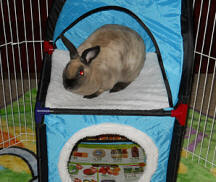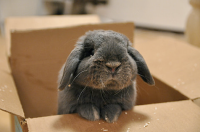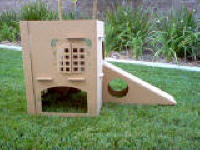|
|

Play is good for both you and your Pet. It relieves stress, prevents health problems and destructive behaviors, and adds enjoyment to the relationship. You can initiate play by rolling toys or shaking bells. Let the day's tension go as you wiggle and giggle, and watch your Pet light up in response.
Rabbits are playful
creatures and providing
playtime gives your new
Pet an opportunity to
interact with you in a
fun manner while also
helping your rabbit get
the exercise they need. A lack of appropriate opportunities for play, understimulation, and an excess of unused energy can all lead to play aggression.
The mental stimulation
provided by playtime
will keep your new Pet
happy and healthy and
allows for additional
positive experiences
with you!
Teach Gentle Play
Lead gentle play by example and keep it toy focused. If your Pet can handle it without play biting, add lots of head and back rubs. Keep play light-hearted, fun, and interesting.
Stop the play session before your rabbit shows declining interest. With clear instruction from you, your Pet will quickly learn what is acceptable.
Independent Play
Providing
your rabbit with means
to occupy themselves
when alone will help keep
destructive behavior at
bay. Countless bunny
owners have come home to
find the chair next to
the cage has a leg with
a big chunk missing.
Since rabbit teeth
constantly grow, chewing
is an opportunity for
them to keep the length
under control. Ask
yourself, "Is this a toy
I would give a baby?"
Nine times out of ten,
your rabbit will end up
with their toys in their
mouths. Be mindful of
harmful paints, toxic
materials, unsafe glue,
and small parts before
giving your new Pet
anything to play with.
When selecting toys for
your new Pet, keep in
mind that rabbits like
chewing, burrowing, and
occasionally tossing
things around.
Favorite toys
for rabbits include:

- Paper bags
- Socks filled with hay
- Cardboard boxes with a holes
cut out
- Small blocks or chew
sticks
- Wicker baskets (not treated or painted)
- Dried pine cones and non-toxic tree branches
- Cardboard paper towel
rolls
- Hard plastic baby toys
- Old towels (cut off frayed ends as they occur to prevent strangulation)
- Stainless steel bells or toys that make lots of clanging noises
- Small cat toys with no
removable parts
- Cat climbing structures with ramps, tunnels, and platforms
- Food puzzles (Available
at any Pet store)
These ideas are just the
beginning! Use your
imagination when
deciding what your
rabbit will love to play
with and remember to
look around your house.
Food puzzles are an excellent choice for playtime as they provide both mental and physical stimulation. Alternate toys on a weekly basis to keep your guinea pig interested and excited.
Setting up and cleaning
up after playtime is
important, especially
when you take your Pet
out at least once a day.
Line the area your
rabbit will be spending
time with newspaper,
when finished, simply
roll up the newspaper
and dispose of it.
Don't overlook the power
of quiet time together.
Simply spending time
cuddled up together on
the couch will do
wonders for you and your
Pet. Those quiet moments
spent together while
gently stroking your
rabbit will be tops on
your list of positive
interactions. You may
even look down to find
your rabbit sound asleep
on your lap!
|